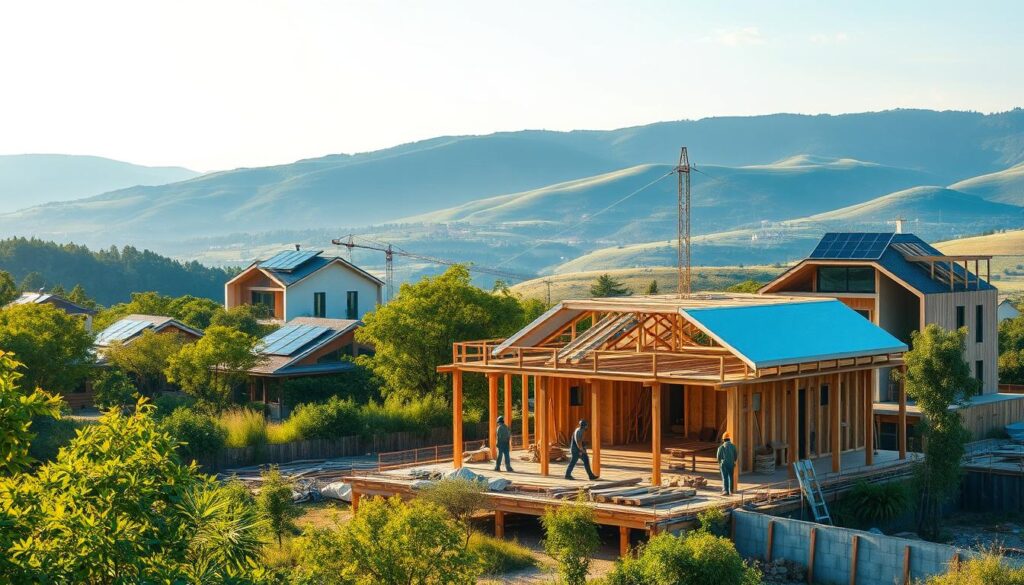The construction industry is one of the largest contributors to global greenhouse gas emissions, making sustainable construction practices more crucial than ever.
Innovative designs in green building engineering are revolutionizing the way we construct buildings, significantly reducing environmental footprint. For instance, LEED-certified buildings at UT Dallas showcase successful implementations of eco-friendly design principles.
By adopting these practices, we can minimize the environmental impact of construction and create a more sustainable future.
Key Takeaways
- Innovative designs in green building engineering reduce environmental footprint.
- Sustainable construction practices are crucial for minimizing greenhouse gas emissions.
- LEED-certified buildings are examples of successful eco-friendly design implementations.
- Eco-friendly design principles are essential for sustainable construction.
- Adopting sustainable practices can lead to a more sustainable future.
Introduction to Green Building Engineering
Green building engineering is an interdisciplinary field that combines engineering principles with sustainable design to create energy-efficient structures. This field is crucial in the modern construction industry as it aims to reduce the environmental footprint of buildings.
What is Green Building Engineering?
Green building engineering involves the application of engineering principles to design, construct, and operate buildings in a way that minimizes their environmental impact. This includes the use of green architecture technology to optimize energy consumption, reduce waste, and promote sustainability.
For instance, the Student Services Building at UT Dallas achieved LEED Platinum certification through energy-efficient designs, showcasing the potential of green building engineering in real-world applications. To learn more about sustainable building materials, visit sustainable building materials.
| Key Components | Description | Benefits |
|---|---|---|
| Energy Efficiency | Designs and systems that reduce energy consumption | Lower utility bills, reduced carbon footprint |
| Sustainable Materials | Materials that are recycled, recyclable, or sustainably sourced | Reduced environmental impact, improved indoor air quality |
| Water Conservation | Systems that reduce water usage and promote water recycling | Conservation of water resources, reduced water bills |
Importance of Sustainability in Construction
Sustainability in construction is crucial for reducing carbon emissions and conserving resources. Green building engineering plays a vital role in achieving these goals by incorporating sustainable practices and materials into building design and construction.
The importance of sustainability is further highlighted by the growing demand for LEED certification and other green building standards. These certifications not only promote sustainable practices but also enhance the market value of buildings.
Key Principles of Green Building Design
Green building design is centered around several key principles that aim to reduce environmental impact while enhancing occupant health and productivity. These principles are crucial in guiding architects, engineers, and builders towards creating structures that are not only environmentally friendly but also economically viable and socially responsible.
Energy Efficiency
Energy efficiency is a cornerstone of green building design. It involves the use of energy-efficient systems and technologies to minimize energy consumption. This can be achieved through various means, such as optimizing building orientation, using high-performance insulation, and installing energy-efficient lighting and HVAC systems.
Moreover, incorporating renewable energy sources like solar and wind power can significantly reduce a building’s reliance on non-renewable energy, thereby decreasing its carbon footprint.
Water Conservation
Water conservation is another critical aspect of green building design. It involves implementing strategies to reduce water usage and promote water efficiency. Techniques such as rainwater harvesting and greywater recycling can significantly reduce a building’s water consumption.
Additionally, using low-flow fixtures and appliances can further contribute to water conservation efforts.
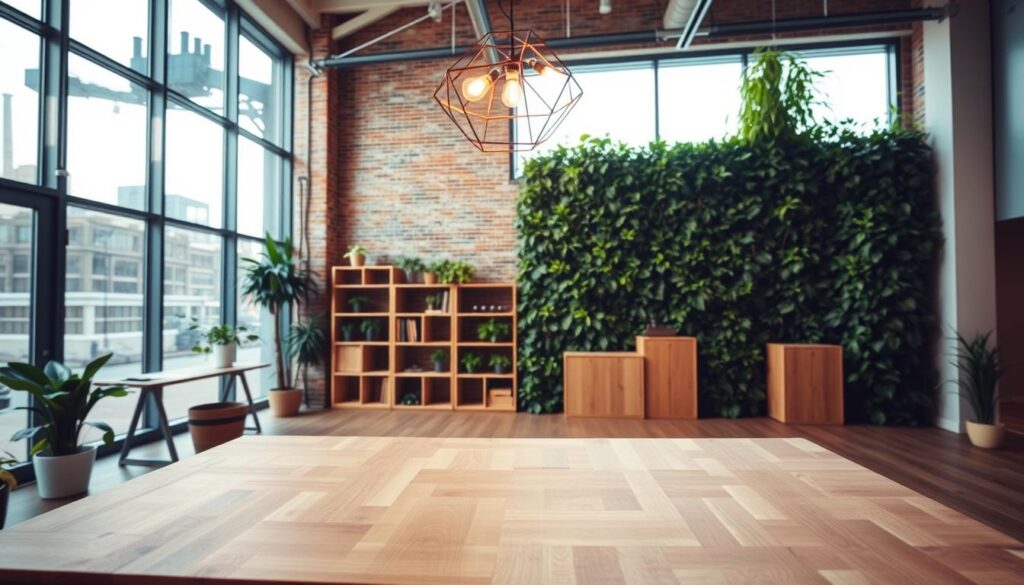
Indoor Environmental Quality
Indoor environmental quality (IEQ) refers to the conditions inside a building that affect the health, comfort, and productivity of its occupants. Enhancing IEQ involves improving indoor air quality, providing adequate lighting, and maintaining a comfortable indoor temperature.
Strategies to improve IEQ include using non-toxic and low-emission materials, enhancing ventilation systems, and incorporating daylighting techniques.
Sustainable Materials
The selection of sustainable materials is vital in green building design. It involves choosing materials that are environmentally friendly, sustainable, and have a low environmental impact throughout their lifecycle.
Examples of sustainable materials include recycled and reclaimed materials, sustainably sourced wood, and materials with low embodied energy. The use of such materials not only reduces the environmental impact of a building but also promotes sustainable practices within the construction industry.
Benefits of Green Building Engineering
By embracing green building engineering, we can significantly enhance the sustainability and efficiency of our built environment. This approach to construction not only benefits the environment but also offers economic advantages and improves the quality of life for occupants.
Economic Advantages
Green building engineering can lead to significant cost savings over the life of a building. Energy-efficient systems reduce utility bills, while durable and sustainable materials minimize maintenance and replacement costs.
- Reduced energy consumption through efficient systems
- Lower water bills due to conservation measures
- Increased property value with sustainable features
| Economic Benefits | Traditional Building | Green Building |
|---|---|---|
| Energy Costs | $100,000/year | $60,000/year |
| Water Costs | $20,000/year | $10,000/year |
| Maintenance Costs | $30,000/year | $15,000/year |
Environmental Impact
Green buildings are designed to minimize their environmental footprint. This is achieved through the use of sustainable materials, reduction in energy consumption, and implementation of effective waste management systems.
Enhanced Quality of Life
Green buildings not only benefit the environment and the bottom line, but they also enhance the quality of life for their occupants. Improved indoor air quality and natural lighting contribute to a healthier and more productive living and working environment.
“Green buildings are a crucial step towards a more sustainable future. They offer a unique combination of economic, environmental, and social benefits that can significantly improve our quality of life.”
Energy-Efficient Technologies
Energy-efficient technologies play a crucial role in modern green building design and operation. These technologies are designed to reduce energy consumption, lower operational costs, and minimize environmental impact. By integrating innovative solutions such as solar energy systems, green roofs, and smart building automation, architects and engineers can create buildings that are not only sustainable but also highly functional and comfortable.
Solar Energy Solutions
Solar energy solutions are a key component of energy-efficient buildings. Photovoltaic (PV) systems convert sunlight into electricity, reducing reliance on traditional energy sources. For instance, a building integrated with a PV system can significantly lower its energy bills and contribute to a cleaner environment. To learn more about energy-efficient building technologies, visit this resource.
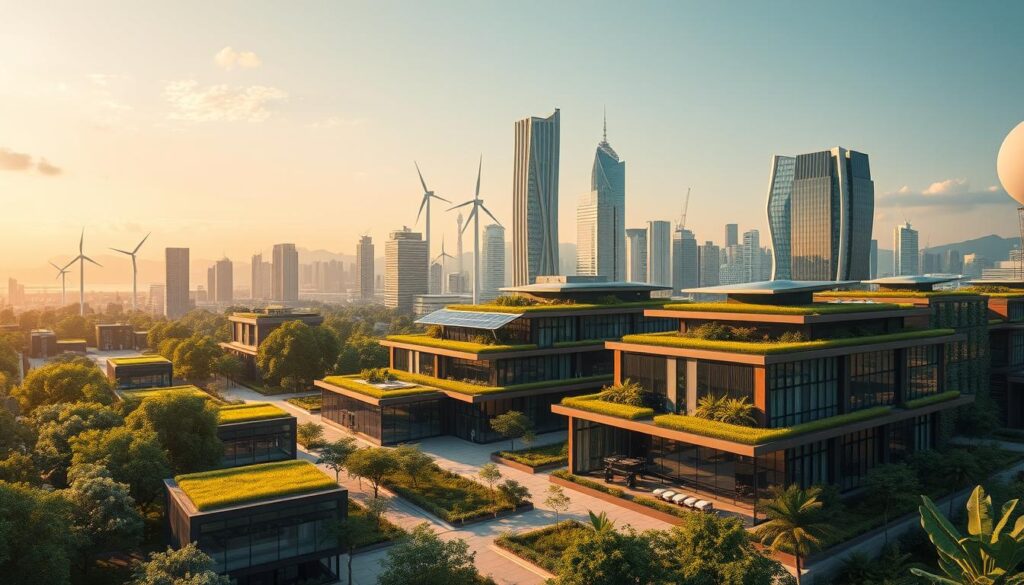
Green Roof Systems
Green roof systems offer multiple benefits, including insulation, stormwater management, and habitat creation. By incorporating vegetation on rooftops, buildings can reduce heat island effects and improve air quality. Green roofs can be intensive or extensive, depending on the depth of the soil and the type of vegetation used.
Smart Building Automation
Smart building automation systems optimize building performance by controlling lighting, heating, cooling, and security. These systems use sensors and data analytics to ensure that buildings operate efficiently and respond to occupant needs. For example, smart lighting systems can adjust based on occupancy and natural light availability, reducing energy waste.
By embracing these energy-efficient technologies, buildings can achieve higher levels of sustainability and performance. Moreover, such buildings are more likely to attain LEED certification, a recognized standard for green buildings. As the construction industry continues to evolve, the integration of green architecture technology will remain pivotal in creating energy-efficient structures that support a sustainable future.
Water Conservation Strategies
As the world moves towards more sustainable construction practices, water conservation strategies are becoming a focal point in green building design. Effective water management is crucial for reducing the environmental impact of buildings and promoting eco-friendly design principles.
Rainwater Harvesting
Rainwater harvesting is a simple yet effective strategy for conserving water in green buildings. By collecting and storing rainwater, buildings can reduce their reliance on municipal water supplies for non-potable purposes such as flushing toilets and irrigating landscapes. According to the Forest Nation blog, rainwater harvesting systems can significantly reduce water consumption in buildings.
Benefits of Rainwater Harvesting:
- Reduces stormwater runoff
- Decreases demand on municipal water supplies
- Provides a free source of water for non-potable uses
Greywater Recycling
Greywater recycling involves treating and reusing wastewater generated from sinks, showers, and washing machines for irrigation and flushing toilets. This strategy can significantly reduce a building’s water consumption and is an important aspect of sustainable construction practices.
| Greywater Recycling Benefits | Water Savings |
|---|---|
| Reduces wastewater generation | Up to 50% reduction in water consumption |
| Provides a reliable source of water for irrigation | Decreases demand on potable water supplies |
Efficient Irrigation Systems
Efficient irrigation systems are designed to minimize water waste while maintaining healthy landscapes. Techniques such as drip irrigation and the use of drought-resistant plants can significantly reduce water consumption in green buildings.
“Implementing efficient irrigation systems is a critical step towards achieving water conservation in green buildings. By using advanced technologies and sustainable landscaping practices, buildings can reduce their water footprint while maintaining aesthetic appeal.”
In conclusion, incorporating water conservation strategies such as rainwater harvesting, greywater recycling, and efficient irrigation systems is essential for promoting sustainable construction practices and reducing the environmental impact of green buildings.
Sustainable Material Selection
Sustainable material selection is a cornerstone of green building engineering, enabling the creation of structures that are both environmentally friendly and economically viable. The choice of materials significantly impacts the environmental footprint of a building throughout its lifecycle, from construction to demolition.
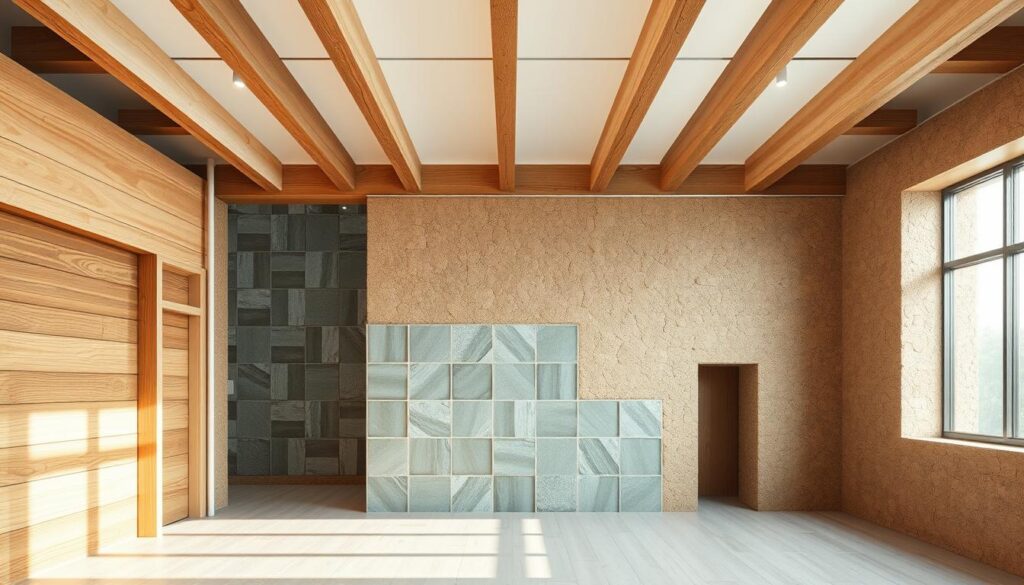
The use of recycled and upcycled materials is gaining traction in green building projects. These materials reduce the need for virgin resources, decrease waste, and often require less energy to process. Examples include recycled steel, reclaimed wood, and recycled glass. For instance, using reclaimed wood not only reduces deforestation but also adds unique character to buildings. Sustainable material selection plays a vital role in minimizing environmental impact.
Recycled and Upcycled Materials
Recycled materials are those that have been processed from products that have reached the end of their service life. Upcycled materials, on the other hand, are creatively repurposed without significant processing. Both approaches help in reducing waste and conserving natural resources.
- Recycled steel reduces the need for new raw materials and saves energy.
- Reclaimed wood preserves the history and character of old buildings.
- Recycled glass can be used in countertops, flooring, and insulation.
Low-Impact Manufacturing
Low-impact manufacturing processes are crucial for minimizing the environmental footprint of building materials. This involves using production methods that consume less energy, generate minimal waste, and emit fewer greenhouse gases. Manufacturers are increasingly adopting sustainable practices, such as using renewable energy sources and reducing water consumption.
Some key strategies include:
- Utilizing renewable energy sources like solar or wind power.
- Implementing efficient waste management systems.
- Reducing water usage through advanced manufacturing technologies.
Certifications and Standards
Various certifications and standards help ensure that building materials meet certain sustainability criteria. One of the most recognized certifications is LEED (Leadership in Energy and Environmental Design), which provides a framework for healthy, efficient, and cost-effective buildings. Other standards include the International Organization for Standardization (ISO) and the Forest Stewardship Council (FSC) certification for wood products.
By choosing materials that adhere to these standards, builders can ensure that their projects meet high sustainability benchmarks, contributing to a more environmentally conscious construction industry.
Building Codes and Green Certifications
As the construction industry evolves, building codes and green certifications play a crucial role in promoting sustainable practices. These standards ensure that buildings are not only environmentally friendly but also safe and efficient.
The importance of adhering to rigorous building codes and obtaining green certifications cannot be overstated. They serve as benchmarks for the industry, pushing developers to adopt innovative, sustainable solutions. Various certification systems have been developed to cater to different aspects of green building.
LEED Certification
LEED (Leadership in Energy and Environmental Design) is one of the most widely recognized green building certification programs worldwide. It provides a framework for designing, constructing, and operating high-performance green buildings. LEED certification is awarded based on a point system, with categories including energy efficiency, water conservation, and indoor environmental quality.
For more information on green building standards and certification systems, visit https://www.wbdg.org/resources/green-building-standards-and-certification-systems.
Energy Star Rating
The Energy Star rating is a program run by the U.S. Environmental Protection Agency (EPA) that promotes energy efficiency in buildings. It provides a simple, credible way to identify buildings that are energy efficient. Buildings that earn the ENERGY STAR label must meet specific energy performance standards set by the EPA.
National Green Building Standard
The National Green Building Standard is a consensus-based standard that provides a comprehensive framework for green building practices. It covers aspects such as site development, energy efficiency, and indoor environmental quality. This standard is used across the United States and is adaptable to various types of construction projects.
| Certification System | Focus Area | Benefits |
|---|---|---|
| LEED Certification | Comprehensive green building practices | Enhanced environmental performance, increased property value |
| Energy Star Rating | Energy efficiency | Reduced energy consumption, lower utility bills |
| National Green Building Standard | Consensus-based green building practices | Flexible, adaptable to various construction projects |
In conclusion, building codes and green certifications are essential for advancing sustainable construction practices. By understanding and implementing these standards, builders and developers can contribute to a more environmentally friendly built environment.
The Role of Engineers in Green Building
Engineers play a pivotal role in green building engineering, driving sustainability through innovative designs and technologies. Their expertise is crucial in ensuring that green building projects are executed efficiently and effectively.
Collaborating with Architects and Designers
Collaboration between engineers, architects, and designers is essential in green building projects. This interdisciplinary approach ensures that buildings are not only aesthetically pleasing but also sustainable and functional. For instance, engineers can work with architects to optimize building orientations for natural light and passive solar heating, reducing the need for artificial lighting and heating systems.
As noted by experts, “Effective collaboration in green building design can lead to significant energy savings and reduced environmental impact.”
“The integration of engineering and architectural design is key to achieving sustainable buildings that meet both functional and aesthetic requirements.”
Conducting Life Cycle Assessments
Engineers conduct life cycle assessments (LCAs) to evaluate the environmental impacts of building materials and systems throughout their entire life cycle, from extraction and processing to operation and disposal. This comprehensive analysis helps in selecting materials and designing systems that minimize environmental footprint.
| Life Cycle Stage | Environmental Impact | Engineer’s Role |
|---|---|---|
| Material Extraction | Resource depletion, habitat destruction | Specify sustainable materials |
| Construction | Energy consumption, waste generation | Implement efficient construction practices |
| Operation | Energy consumption, water usage | Design energy-efficient systems |
Implementing Renewable Technologies
Engineers play a vital role in implementing renewable technologies such as solar energy systems, wind turbines, and geothermal systems in green buildings. These technologies reduce reliance on fossil fuels and lower greenhouse gas emissions. For more information on emerging green building innovations, visit https://worldcivilsociety.com/emerging-green-building-innovations/.
By integrating renewable energy systems, engineers can significantly enhance the sustainability of buildings. For example, solar panels can be integrated into building facades to generate electricity while serving as a building envelope component.
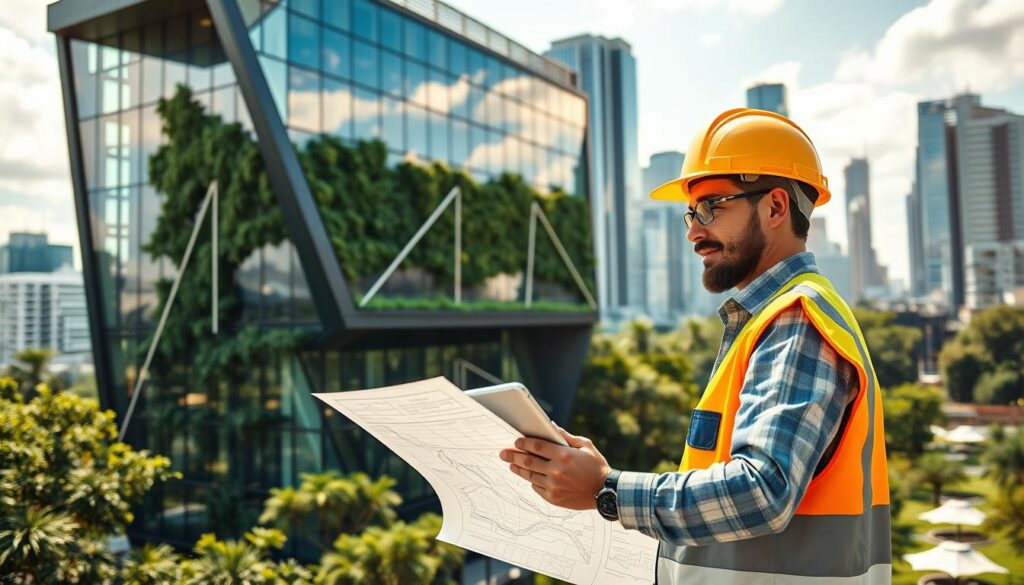
Innovations in Green Building Engineering
Innovations in green building engineering are revolutionizing the construction industry with sustainable practices. The integration of new technologies and materials is not only enhancing the environmental performance of buildings but also improving their functionality and efficiency.
The construction industry is witnessing a significant shift towards sustainability, driven by the need to reduce environmental impact. Green building engineering is at the forefront of this shift, incorporating innovative techniques such as modular construction, 3D printing, and biophilic design.
Modular Construction Techniques
Modular construction involves assembling building modules in a factory and then transporting them to the construction site. This technique reduces waste, improves quality control, and accelerates the construction process. Modular construction is particularly beneficial for projects with tight deadlines and complex designs.
3D Printing in Construction
3D printing technology is being increasingly used in construction to create complex building components with high precision. This method reduces material waste and enables the creation of intricate designs that would be difficult to achieve with traditional construction methods. 3D printing is paving the way for more sustainable and innovative building practices.
Biophilic Design Concepts
Biophilic design incorporates natural elements into building design to enhance occupant well-being and productivity. This approach includes the use of natural materials, green spaces, and ample natural light. By reconnecting building occupants with nature, biophilic design promotes a healthier and more sustainable built environment.
The adoption of these innovations in green building engineering is crucial for achieving sustainability goals in the construction industry. As the industry continues to evolve, we can expect to see even more groundbreaking technologies and design principles being implemented.
Case Studies of Successful Green Buildings
Successful green buildings are redefining the future of urban development. These structures not only minimize environmental impact but also provide healthy, productive spaces for occupants. In this section, we will explore three notable examples of green buildings that have achieved significant sustainability milestones.
The Edge, Amsterdam
The Edge in Amsterdam is often cited as one of the most sustainable office buildings in the world. Completed in 2015, it boasts an impressive 98.36% score on the BREEAM assessment, a leading sustainability rating system. The building’s design incorporates numerous green features, including a rainwater harvesting system and efficient LED lighting controlled by a sophisticated smart building technology system.
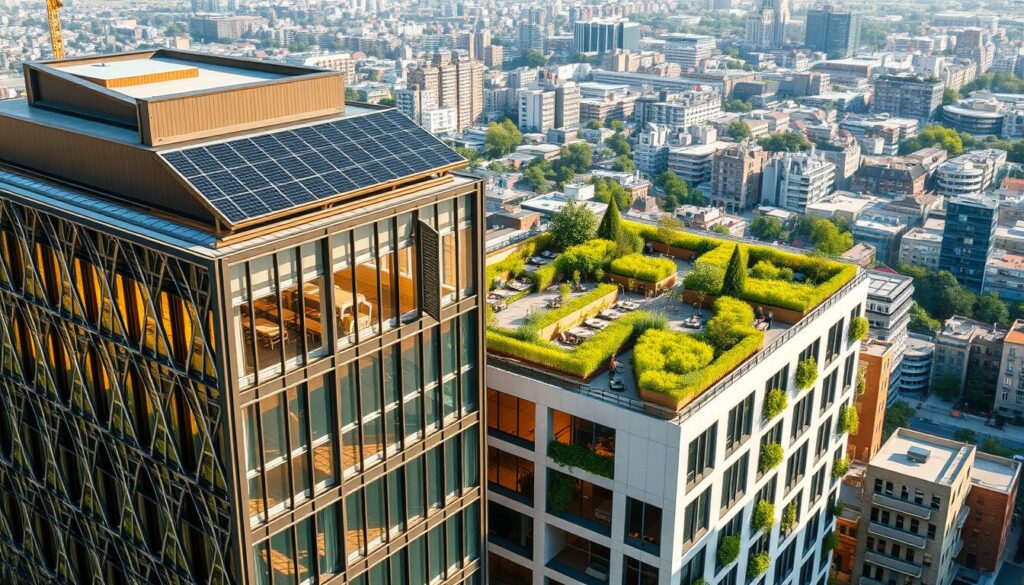
The Edge’s design prioritizes natural light and ventilation, reducing the need for artificial lighting and heating/cooling systems. Its innovative skyscraper design engineering has set a new standard for office buildings, demonstrating that sustainability and commercial viability can go hand-in-hand.
Bosco Verticale, Milan
Bosco Verticale, or “Vertical Forest,” in Milan is a pioneering residential tower that has become an iconic example of urban reforestation. Completed in 2014, the building features over 900 trees and 20,000 plants, which not only enhance its aesthetic appeal but also contribute to improved air quality and biodiversity in the city.
| Feature | Description | Benefit |
|---|---|---|
| Tree and Plant Coverage | Over 900 trees and 20,000 plants | Improved air quality and biodiversity |
| Sustainable Materials | Use of recycled and locally sourced materials | Reduced environmental impact |
| Energy Efficiency | Advanced insulation and energy management systems | Lower energy consumption |
Bullitt Center, Seattle
The Bullitt Center in Seattle is a LEED Platinum-certified building that exemplifies the principles of green building engineering. Completed in 2013, it is designed to be one of the most environmentally responsible buildings in the world. The center features a 244 kW solar array, making it one of the most energy-efficient commercial buildings in the United States.
The Bullitt Center’s design emphasizes sustainability through the use of non-toxic materials, a rainwater collection system, and a highly efficient building envelope. It serves as a model for future construction projects, showcasing the potential for buildings to be both environmentally friendly and economically viable.
In conclusion, these case studies demonstrate the potential of green building engineering to transform urban environments. By incorporating sustainable design features and innovative technologies, buildings like The Edge, Bosco Verticale, and the Bullitt Center are setting new standards for environmental responsibility in the construction industry.
Challenges in Green Building Engineering
Despite the growing demand for sustainable construction practices, green building engineering faces several challenges that hinder its widespread adoption. As the construction industry continues to evolve, addressing these challenges is crucial for the future of environmentally conscious construction methods.
The challenges in green building engineering are multifaceted, involving financial, regulatory, and social aspects. Understanding these challenges is the first step towards overcoming them and promoting the adoption of green building practices.
Financial Barriers
One of the significant challenges in green building engineering is the financial barrier. The initial investment required for green building technologies and materials can be higher than traditional construction methods. This increased upfront cost can deter developers and investors, making it challenging to secure funding for green building projects.
However, it’s essential to consider the long-term benefits and cost savings associated with green buildings, such as reduced energy consumption and lower operational costs. To overcome financial barriers, exploring innovative financing options and incentives for green building projects is crucial. For more information on sustainable engineering practices, visit Sustainable Engineering: Shaping a Greener Future.
Regulatory Hurdles
Regulatory hurdles also pose a significant challenge to green building engineering. Existing building codes and regulations may not support or may even hinder the adoption of green building practices. For instance, some building codes may not accommodate new green technologies or materials, creating a barrier to their use.
To address these regulatory hurdles, it’s essential to work with policymakers and regulatory bodies to update and adapt building codes to support green building practices. This collaboration can help create a more favorable environment for the adoption of sustainable construction methods.
Public Perception
Public perception is another challenge faced by green building engineering. There may be a lack of awareness or misconceptions about the benefits and costs associated with green buildings. Educating the public and stakeholders about the advantages of green building, such as improved indoor environmental quality and reduced environmental impact, can help shift perceptions and increase demand for green buildings.
By addressing these challenges and working together, the construction industry can promote the adoption of green building engineering practices, contributing to a more sustainable future.
Future Trends in Green Building Engineering
The future of green building engineering is poised to be shaped by innovative technologies and sustainable practices. As we move forward, the industry is expected to witness significant transformations driven by the need for climate adaptation, technological advancements, and the pursuit of energy efficiency.
Climate Adaptation Strategies
Climate change is one of the most pressing issues of our time, and green building engineering is at the forefront of developing strategies to adapt to its impacts. This includes designing buildings that can withstand extreme weather conditions, such as hurricanes, floods, and droughts. Resilient design is becoming increasingly important, incorporating features like flood-resistant construction, wind-proofing, and adaptive reuse of materials.
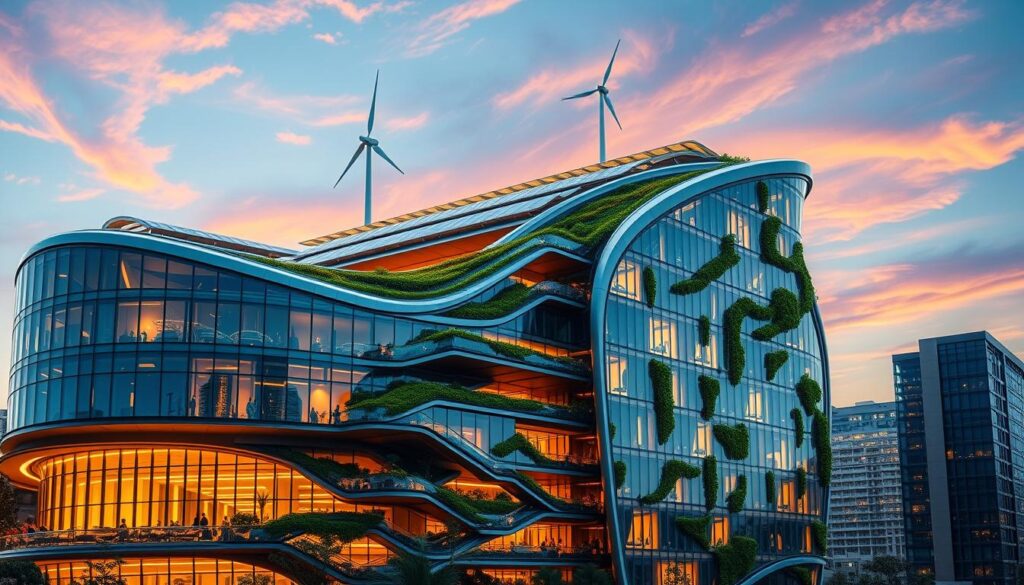
Another key aspect is the use of sustainable building materials that are not only environmentally friendly but also capable of withstanding the challenges posed by climate change. For instance, materials with high thermal mass can help regulate indoor temperatures, reducing the need for heating and cooling.
| Climate Adaptation Strategy | Description | Benefits |
|---|---|---|
| Flood-Resistant Construction | Designing buildings with materials and structures that can withstand flooding. | Reduces damage from floods, lowers insurance costs. |
| Wind-Proofing | Using materials and designs that can resist high winds. | Enhances building durability, reduces maintenance costs. |
| Adaptive Reuse of Materials | Reusing materials from existing buildings in new constructions. | Reduces waste, conserves resources, lowers construction costs. |
Integration of AI and Machine Learning
The integration of Artificial Intelligence (AI) and Machine Learning (ML) in green building engineering is revolutionizing the way buildings are designed, constructed, and operated. AI and ML can optimize energy consumption, predict maintenance needs, and enhance the overall efficiency of building systems.
- Predictive maintenance: AI can predict when maintenance is required, reducing downtime and extending the lifespan of building systems.
- Energy optimization: ML algorithms can analyze data from various sources to optimize energy consumption, reducing waste and lowering costs.
- Smart building automation: AI can automate various building functions, such as lighting and HVAC, to create a more comfortable and efficient environment.
Zero Energy Buildings
Zero Energy Buildings (ZEBs) are designed to produce as much energy as they consume over the course of a year. Achieving this balance requires a combination of energy-efficient design, renewable energy systems, and advanced building technologies.
The benefits of ZEBs are numerous, including reduced energy costs, lower greenhouse gas emissions, and improved indoor air quality. As technology continues to advance, the feasibility and affordability of ZEBs are expected to increase, making them a more viable option for building owners and developers.
Conclusion: The Future of Sustainable Construction
As the construction industry continues to evolve, embracing green building engineering and sustainable construction practices is crucial for a more environmentally friendly future. The integration of eco-friendly design principles not only reduces the environmental impact of buildings but also enhances their durability and energy efficiency.
Community Engagement for a Greener Tomorrow
Community engagement plays a vital role in promoting sustainable practices in construction. By involving local communities in the planning and development process, builders can ensure that projects meet the needs of the community while minimizing environmental harm.
Adopting Sustainable Practices
The future of sustainable construction relies on the adoption of innovative technologies and practices. By incorporating green building engineering principles, the construction industry can significantly reduce its carbon footprint and contribute to a more sustainable built environment. It is essential for architects, engineers, contractors, and policymakers to collaborate and drive the shift towards more eco-friendly construction methods.
